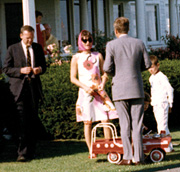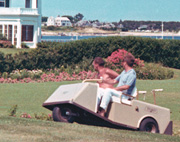Jack and Lem continued 2

I remember reading in the book that Lem had all this information that nobody else seemed to have.
Most of the people around Jack Kennedy had met him after the war when his political career began, and Jackie hadn’t met him until 1951. So almost nobody outside the family knew him from 1933. So that was important to her. And he saw much less of them when she moved outside of the United States after her marriage to Onassis. But when she returned in the mid-’70s and started working in New York, they were teenagers by then, and they would go over to his place by themselves. So they knew him quite well, Caroline probably a little bit more than John Jr.
Didn’t Lem basically have his own room in the White House?
It was on the third floor. The chief White House usher at the time, J. B. West, confirmed that, and it was basically his room. And Lem himself talked about it in his oral history.
How important was that oral history?
That document was vital to this book. It’s 815 pages. I was working on the book for three years, and for most of the time I couldn’t get access to it, because although it’s in the Kennedy Library, it’s off limits to authors and journalists. The only person who can give you permission to get to it is Robert F. Kennedy Jr., and he finally gave me permission in the final months when I was preparing the book.
Do you know why he finally gave in?
I don’t. I pestered him a lot, sending letters. That may have been part of the reason. He also probably checked me out as a journalist [Pitts has written various articles on John Kennedy] and realized I wasn’t some kind of far-right writer. The Kennedys are getting kind of suspicious of journalists these days, because there have been a lot of trash books or political-attack books from the right about the Kennedys in recent years, so that may have been one reason for his caution, but I really don’t know.

Wasn’t Lem such a regular visitor at the White House that security would let him pass without some kind of badge?
Yes, they did. He never had a White House pass. He said all the guys knew him, and he just waltzed right on in there. He was also a frequent guest at the president’s retreat outside Washington in Glen Ora, Virginia.
Where was Lem when Kennedy was assassinated?
He was in New York. He was on his lunch hour from his job at an advertising company called Lennen & Newell.
Is there any information on how it affected him at the time?
Not immediately. I wasn’t able to talk to anybody who talked to him that day. I think the only person he did talk to was Eunice Kennedy Shriver, who was at the White House at the time. But his close friends, Frances McAdoo and John Seigenthaler, talked to him within the next few days after it happened, and they described him as you can imagine—devastated, just unable to process it all.
But at the time he was very helpful to the family.
He knew this was going to be a time of incredible anguish for the Kennedy family. He knew all of them from the early 1930s, when Jack used to take him to Palm Beach in Hyannis Port. He felt incredibly responsible and loyal to them. He held himself together through the funeral period and then just fell apart.
I found it very interesting that a gift from Lem was buried with Kennedy. Were there other things buried with him?
I don’t know the answer to that, although I understand that Jackie Kennedy was going to have the ring he’d given her buried with him, and somebody persuaded her she should keep it. So that’s the only other gift I know about. But the gift from Lem that was buried with him was a set of whale’s-tooth scrimshaw. This is apparently something that Kennedy had been interested in collecting over the years, and Lem had given him some, and it had been on the desk of the president in the White House.
I find that fascinating. It brings it back again to how close they were. Did Lem ever recover from the assassination?
Not in total. Grief is a strange thing. Some days he’d be the same old Lem joking, and other days he would think about what had happened. It was something that he apparently was never able to come to terms with. The best way he seemed to be able to deal with it was to talk about JFK to the younger Kennedys, to journalists, really to anybody who would listen.
Didn’t he remain a part of the Kennedy family?
He became very close to Senator Robert Kennedy. But that wasn’t just the post-1963 phenomenon either. He’d known Bobby since the early 1930s, and it was natural that they would become close since he’d seen so much of Jack Kennedy in Bobby, and he had it happen all over again in 1968 when Bobby was killed.
Did he help in Bobby’s campaign?
He was very involved in his campaign first when he ran for senator of New York in 1964 and then in the presidential campaign in 1968. And he was professionally involved. His company, Lennen & Newell, was involved in doing many of the political commercials that aired at the time. He was closely involved in Robert Kennedy’s political efforts as well.
Wasn’t Lem’s boss not only a Republican but also charmed by President Kennedy?
A guy by the name of Adolph Toigo–yes, he was a Republican, as indeed was Lem until 1960. This is really one of the funny things because Lem’s family was a Republican family, and Lem himself was a registered Republican–he switched his registration in 1960–and so were some of the other people we were just talking about. I guess it’s part of John Kennedy’s charisma. He met with some of Lem’s friends, including Lem’s boss, because he wanted Lem to help on the campaign, which was the initial reason, but then he also persuaded the boss to change his political allegiance. It’s incredible his effect on people.
The Kennedys embracing the friendship between Lem and Jack says a whole lot about the family.
Yes, it does. There have been various rumors flying over the years, in some of the right-wing periodicals especially, that Lem, being a gay man, tried to seduce some of the younger Kennedys. I did look into that, but I was able to find no evidence of that, and certainly none of the younger Kennedys, including Bobby Kennedy, has said that was the case.
How did Lem die?
He died of a heart attack in 1981 at the age of 65. Although when I looked into it a little bit more, he did have a heart condition for some time, and to what degree his drinking contributed to that, I’m not really sure. But the technical cause of death was a heart attack.
Not long before that, didn’t he still see the younger kids?
Right. After Senator Robert Kennedy’s assassination in June of 1968, he then became close to Robert F. Kennedy Jr., the person who gave me permission to look at the documents. This seems to have been the instigation of Ethel Kennedy, who had 11 children. Again, Lem knew Bobby from when he was a little kid, and she asked various people to help out with the boys. Some other guys helped out with the other boys, and she asked Lem to help out with Bobby. So they became really close. Bobby Kennedy Jr. was only 14 when his father was assassinated. So Lem took Bobby under his wing, and they often went on vacations together, and Bobby was often at his New York townhome.
Did the fact that you are gay prove a help or a hindrance in writing the book?
I don’t really feel that it either helped or hindered me in writing the book. I took a journalistic approach in writing this. I only included information in the book that I could verify either through documentary evidence or with interviewees in a position to know.
I think President Kennedy–if he were alive today–would be horrified at the resurgence of conservatism and the attack on civil liberties in the United States. Just a few weeks ago even, General Peter Pace, the chairman of the Joint Chiefs of Staff, called homosexual acts immoral–and survived in his job, despite the bigotry. But 47 years ago, we had a president whose best friend was gay and who seemed quite comfortable with it.
Blase DiStefano interviewed Leslie Jordan for the October issue.










